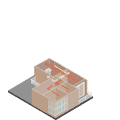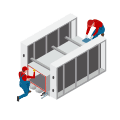Productization in Construction: Efficiency and Innovation
Discover how productization revolutionizes construction project management with enhanced efficiency, sustainability and new tech-driven operational models.
Understanding the Concept of Productization in Construction
The architecture, engineering and construction (AEC) industry is at the precipice of transformation. Demands continue to grow for cost-efficient and sustainable buildings, rapid delivery and customization. Stakeholders have begun to rethink how to best deliver value for more sustainable and cost-effective built environments. Some have turned to prefabrication to overcome logistical issues, but they’re still burdened by increased costs and siloed trades. This creates financial sinkholes that risk construction industry productivity.
Productization is an approach to delivering efficient construction solutions for developers to transform the entire ecosystem for better quality and cost efficiency. Virtual construction bricks, defined by multi-trade assemblies, standardized interfaces and generative variants, are at the heart of this new approach. Standing apart from traditional manufacturing techniques, these sub-systems employ virtual construction twins to revolutionize factory construction and redefine AEC roles to reflect a fundamental shift in the industry.
Productization Delivers Greater Value and Scalability
In our white paper, learn how virtual construction bricks power the shift from trade-based processes to enhance efficiency and sustainability for construction productization.
Economic and Operational Advantages
Productization presents a unique opportunity for cost savings by facilitating a highly configurable approach to the building design process through a generative interface. This approach goes beyond building information modeling (BIM) applications to generate digitally accurate representations of construction management systems, thus reducing labor and material expenses that typically creep up in trade-based workflows. Integration-ready modules hold the promise of shorter project timelines, enabling quicker delivery and enhanced throughput. Ultimately, virtual twins on the 3DEXPERIENCE® platform allow companies to:
Engineer virtual construction bricks outside of a project cycle to enhance scalability, cost-efficiency and replication from project to project
Configure hyper-customized geometries and apply generative design to the construction and implementation of sub-systems and sub-assemblies
Avoid prefabrication constraints and decrease construction costs with the introduction of microfactories
Revamp construction management roles, so contractors continue to deliver value to owners
Read the infographic below to discover how prefabrication drives improvements across the construction value chain.
Sustainability, Workforce Transformation and Green Buildings
The traditional development model has spurred an ecological crisis, urging AEC leaders to lean into sustainable construction practices. Virtual construction twins emerge as pivotal tools in realizing this vision, facilitating the delivery of hyper-customized, efficient solutions at scale. By seamlessly integrating real-world feedback and on-site experiences into their digital representations, developers are able to plan material procurement better, optimize construction schedules, and minimize overordering or underutilization of materials, thereby reducing construction waste.
Amidst these transformative shifts, the workforce must adapt to remain competitive. General contractors (GC) should redefine their roles as “prime integrators”, assuming broader project coordination and management responsibilities to cultivate relationships with emerging “virtual makers”— specialty contractors who have virtualized their craft — for integration excellence. Through this, coupled with microfactories, GCs can efficiently deliver and install productized modules in the field, driving innovation and sustainability in the construction industry.
Watch the video below to see how Bouygues Construction uses the 3DEXPERIENCE® platform to drive sustainable construction.
Overcoming Traditional Construction Challenges
The path to productization begins with the call for efficiency, sustainability and personalized construction. Challenges like skilled labor shortages and siloed trades are a thing of the past with current technology solutions. Mass production, while convenient, struggles to adapt to local markets and individual needs, limiting innovation. Prefabrication streamlines logistics but faces size and weight constraints, hindering scalability. Similarly, BIM lacks seamless translation to physical construction, impacting efficiency.
Overcoming these problems requires strategic leadership committed to innovation. Productization positions firms at the forefront of the construction industry through the use of virtual construction bricks that allow variability, speed and hypercustomization. Standardized interfaces and generative designs realize the goal of interoperability, collaboration and optimization across all construction management systems.
Design Green Buildings at Lightning Speed
Find out how AEC leaders can unleash creativity, captivate customers and slash timelines with generative design on the 3DEXPERIENCE® platform.
Productization in the Construction Industry:
Frequently Asked Questions
Explore Our Industry Solution Experiences for Architecture, Engineering & Construction
Our cloud-based, collaborative environments and advacned design and simulation tools can help your team significantly reduce waste and rework, improve visibility and trust across the supply chain, and achieve unprecedented results.




